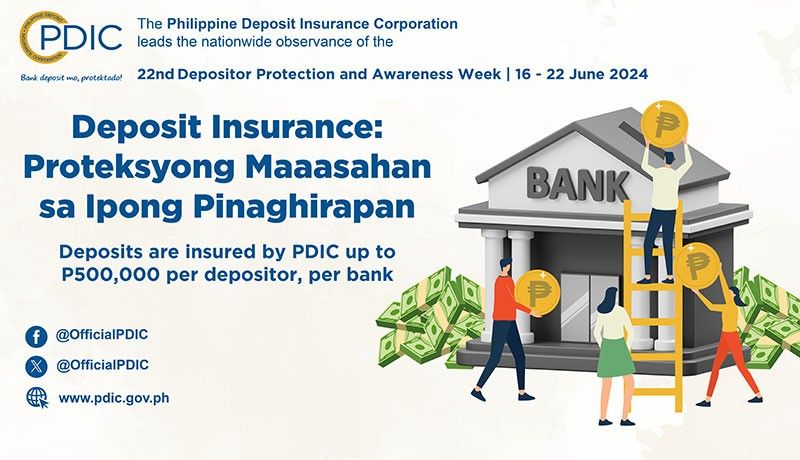Deposit insurance: The reliable protection for your hard-earned bank deposit

MANILA, Philippines — Aivie and her family almost lost all that they had when tropical storm Ondoy unleashed rains of epic proportions on September 26, 2009, submerging their home and everything in it. As soon as the flood waters subsided, they were faced with a very difficult question: how to pick up the pieces and move forward?
One of the keys to her family’s inspiring recovery was having money saved in a bank, which helped protect their finances from being wiped out by the infamous storm. But if savings in banks protected her and many other families' finances from Ondoy’s fury, what then protects their hard-earned bank deposits?
A safety net to protect depositors

Deposit insurance is a safety net mechanism provided by the government through the Philippine Deposit Insurance Corporation (PDIC), the agency designated by law to protect depositors and promote financial stability. The deposit insurance system provides depositors the confidence and peace of mind to maintain their hard-earned savings in banks, particularly for those who are dependent on their bank deposits for present and future needs. With deposit insurance in place, depositors can save without worrying about the safety of their money.
Deposit insurance is also critical in promoting financial stability as it helps heighten public confidence and entices individuals to save more in banks to help grow the economy. The depositing public is encouraged to continue using banking services without fear of losing their savings because of deposit insurance. It likewise helps mitigate risks by assuring depositors that their savings are protected up to the maximum deposit insurance coverage (MDIC), providing no reason to panic during challenging times.
All banks licensed to operate in the country such as commercial, thrift, rural and cooperative banks are covered by deposit insurance. If a bank is ordered closed by the Monetary Board of the Bangko Sentral ng Pilipinas (BSP), PDIC’s deposit insurance guarantees that depositors of the said bank will be promptly reimbursed up to the MDIC of P500,000 per depositor, per bank.
PDIC Tip: To estimate your insured deposits in a bank, use the PDIC’s Deposit Insurance e-Calculator at bit.ly/PDICeCalculator or by scanning the QR code below:

Depositors do not pay for deposit insurance. It is a public policy based on the PDIC Charter (Republic Act No. 3591, as amended) that banks pay assessment dues computed at a flat rate of 1/5 of 1% of their total deposit liabilities. Assessments are collected and pooled with the Deposit Insurance Fund (DIF) managed by the PDIC. The law mandates the PDIC to build the DIF to an adequate level based on the target set by the PDIC Board of Directors. The DIF is the funding source for deposit insurance payments and financial assistance to insured banks.
A key pillar to promote stability
The PDIC was established on June 22, 1963 to protect depositors and promote financial stability. It was the fifth and second deposit insurance system created in the world and Asia, respectively.

As the Philippine economy and financial system continued to grow and evolve, so did PDIC’s deposit insurance coverage. Initially at P10,000 in 1963, the MDIC was increased five times in the last 60 years up to P500,000 per depositor, per bank since 2009. The PDIC Charter was also amended several times in the last 60 years, the most recent of which was two years ago in 2022 to reinforce the role of deposit insurance as a financial safety net.
PDIC is a strategic player in supporting the stability of the financial system by building public confidence in banking institutions. As it performs its role as deposit insurer, the PDIC contributes to promoting a resilient financial sector and a robust economy.
To this end, the PDIC is poised to draw up responsive measures to implement the key amendments to its Charter including studies to review the MDIC based on inflation and other economic indicators, to establish a risk-based assessment scheme to promote governance and market discipline; and to formulate a separate Islamic deposit insurance system to cover certain products and arrangements in Islamic banks deemed as deposits by the BSP.
Deposit insurance is an important pillar of public trust and confidence, and it is most effective when it stands alongside other pillars of security for a sound and stable financial sector. As the banking landscape evolves, continued revisiting and enhancements to the Philippine deposit insurance system are crucial to ensure this pillar of stability remains relevant and responsive to the needs of the depositing public.
Fifteen years later, Aivie and her family have not just picked up the pieces from Ondoy—they are thriving. With the lessons learned from 2009’s infamous disaster, they were able to invest in assets that generate passive income to supplement their work earnings.
We can all learn from their story of preparation and resilience that the best time to start saving up is neither yesterday nor tomorrow but today. And the best way to do this is to save in banks to ensure our hard-earned savings are protected by the PDIC’s deposit insurance.
Note: To know more about deposit insurance, download PDIC’s brochure, Understanding Deposit Insurance (available in English, Filipino, Cebuano and Ilocano) at pdic.gov.ph/pdicbrochures or by watching PDIC’s Deposit Insurance: Mga Dapat Alamin animated explainer video on YouTube at bit.ly/pdic-ev1-deposit-insurance. You can also use the QR codes below to access the brochure and the explainer video.
Understanding Deposit Insurance Brochure:

Animated Explainer Video:

Know more about Aivie’s journey by watching her interview on PDIC’s Official YouTube channel at bit.ly/moneyguro-ep2-youtube or through the QR code below:

#PDIC #DepositInsurance #DPAW2024
Editor's Note: This press release for PDIC is not covered by Philstar.com's editorial guidelines.
- Latest




























